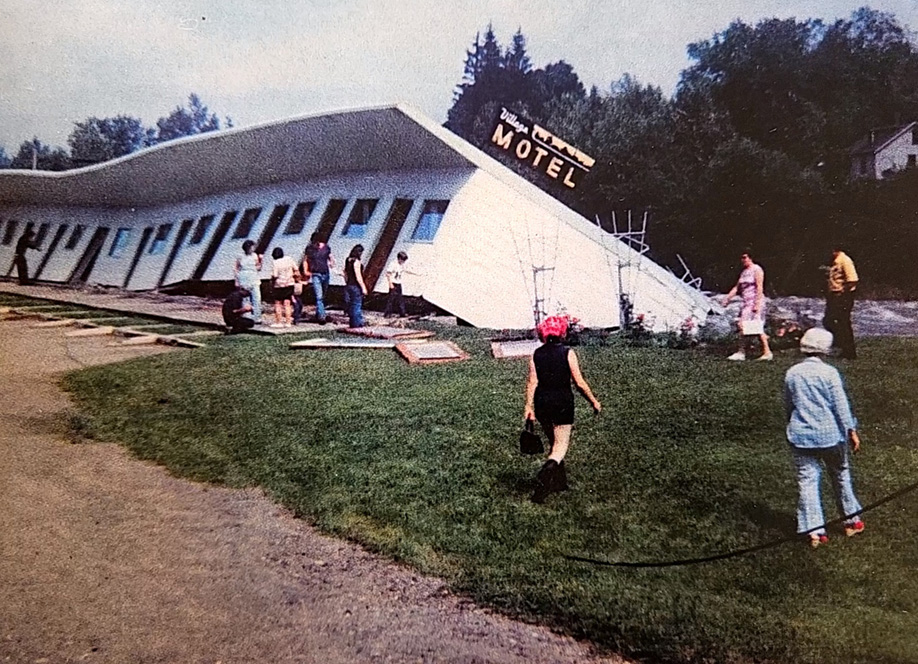
photo courtesy Hardwick Historical Society
Flooding on June 30, 1973 claimed the 12-unit Village Motel, then owned by Mr. and Mrs. Donald Spencer. Preliminary estimates of damage to the property exceeded $150,000 (equivalent to just about $1 million in 2023).
by Tyler Molleur
HARDWICK – Freda Hollyer and her husband Perry reflected on the flooding events of July 10, which took the Inn by the River, formerly known as the Village Motel, down the Lamoille in pieces. The night’s catastrophic flooding event hasn’t been seen in that area in over half a century.
The couple, who has owned the Inn by the River for nearly six years, spent most of this time making significant improvements to the property and helping it stand out as a pillar of commerce for the town. Solar arrays, conversions to gas and electric furnaces, significant room remodeling, installation of new plumbing, and upgrades to the swimming pool were all the work of this couple, with additional renovations planned.
“We were going to tile all the bathroom floors, put new doors and put new ceilings in,” said Perry Hollyer.
The once always-full lodging location, however, sat empty on Wednesday, with the face of the structure still visible from Mill Street. The solar arrays, however, were severely damaged in the flood and the majority of the building could be found scattered among the debris sitting on the riverbank miles downstream.
“We’re still very sad, not for us, but our community,” said Freda Hollyer.

photo courtesy Hardwick Historical Society
Severe damage to the village motel after flooding occurred in the early summer of 1973. The heavy rainfall from the storm was preceded by a wet spring. Rainfall totals in many places exceeded six inches during the storm, according to the National Weather Service.
In the evening hours of July 10, the guests at the Inn were evacuated to higher ground and cars were moved. The Hollyers were able to return to retrieve their dogs before the riverbank undermined the structure, but their personal belongings were unable to be saved.
Freda Hollyer said one thing became evident in the events of last week.
“You can’t have a motel there again.”
The 2023 flooding marks the second time the building has fallen into the river. In late June of 1973, Mr. and Mrs. Donald Spencer owned the Village Motel and pictures from the Hardwick Historical Society show an eerie similarity to the damage incurred from flooding at that time.
“The community, as a whole, suffered a tremendous loss when the 12-unit motel was destroyed. The only place where travelers could be kept overnight, the motel was an economic factor to our restaurants, stores, and filling stations. No dollar loss has yet been set on the loss but estimates have ranged well over $150,000 (just over a million dollars in 2023 amounts),” reported the July 11, 1973, edition of the Hardwick Gazette.
Photographs also showed similarities in flooding further downstream on the Lamoille River, where the Jackson Bridge was covered in water. VTrans crews were able to repair the eastern approach to the bridge in last week’s flood to the point it was passable within 24 hours, giving residents of Hardwick access to Morrisville again.
Weather observer reports from the nearest station at the Fairbanks Museum in St. Johnsbury suggested the evolution of 1973’s flooding mirrored the 2023 precipitation season. Some concerns about below-normal rainfall early in the spring gave way to a wet May, in which 5.61 inches of rain fell, followed by 9.65 inches of rain in June. Nearly four inches of that rain fell on the last two days of June as flooding developed. The 1973 storm left $64 million dollars in damage in its wake, which is the equivalent of $439.7 million dollars in 2023. A Presidential disaster declaration was issued and two people were killed in the flooding in Vermont.
Meanwhile, traveling down the Lamoille Valley Rail Trail in the first two miles east of town, the damage quickly adds up as small creeks blew out recently installed culverts and two of the larger bridge decks spanning the Lamoille River dangled into the river itself. A flooding event in the summer of 1995 led the owners of the Lamoille Valley Railroad to abandon operations as repairs to the track became cost-prohibitive in the extent of the damage from that storm and continued erosion in the two years that followed.
On August 5, 1995, major flooding led to a state of emergency being declared as a two-day span of heavy rains took out portions of major roads and was compared by officials to historic flooding of 1927. During the 1995 flood, multiple people attempting to return east from a wedding were routed off of flooded Route 15 and onto Town Hill Road in Wolcott. Given the nighttime nature of the venture, two cars fell into a washout made by the Tamarack Brook. The drivers of two of the cars, Marc Bigelow and William Aldrich, were injured in the incident but managed to escape their cars. Aldrich’s partner, Ellen Redstone, died as the car was swept further downstream.
Given the historical extent of flooding damage to the rail bed, VTrans officials were asked about how improvements were made to anticipate the impacts of future flooding events.
“Nobody could have predicted a storm of this magnitude,” said Joel Perrigo, municipal assistance program manager at VTrans.
Perrigo admitted the modifications to the rail bed were performed within the limitations of rail banking, in which the footprint of a rail bed is conserved in case future use was necessary. The railroad footprint goes back to the early 1870s and within the legal constrictions of rail banking, measures were taken to help the trail withstand the impacts of flooding. This includes increasing the size of culverts and bridge spans to modern-day standards, increasing bridge abutment reinforcements, and adding more slope armoring to prevent erosion.
Significant work lies ahead of state and local transportation officials as well as residents and business owners to repair from this most recent flooding event. The Presidential disaster declaration from this storm makes individual assistance available to those residing in Lamoille and Washington Counties. Additionally, those two counties along with Caledonia and Orleans County are eligible for assistance at a state and local government level. Eligibility may expand as additional disaster assessments are completed.
Damage from the flooding at the motel has cost the Hollyers their home and their business. The owners hope federal disaster assistance will allow them to recover from the event and consider what’s next.







